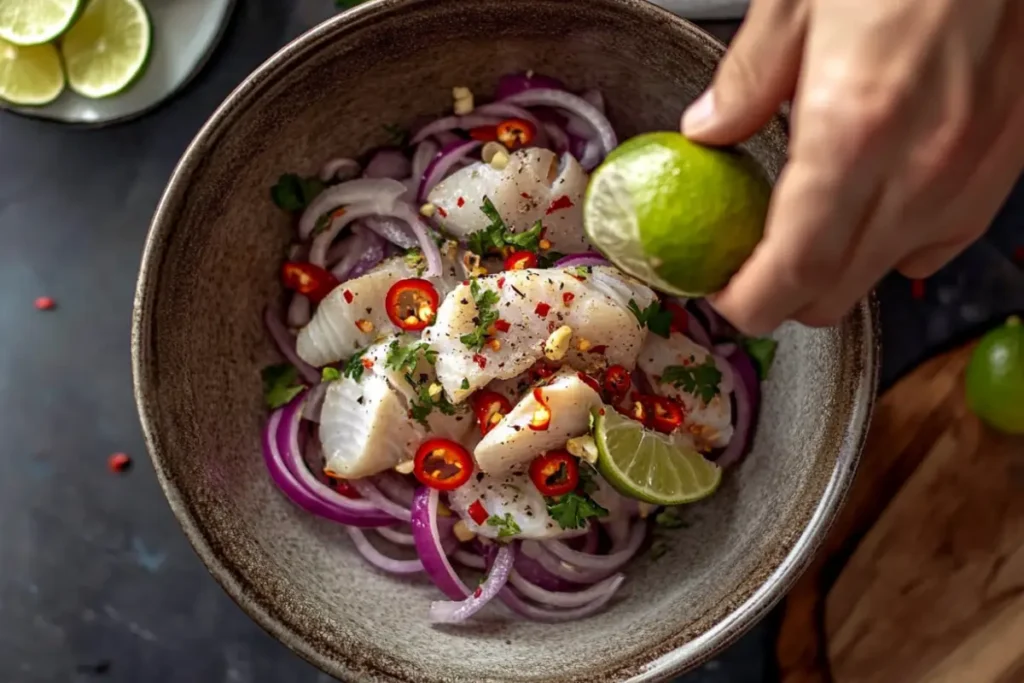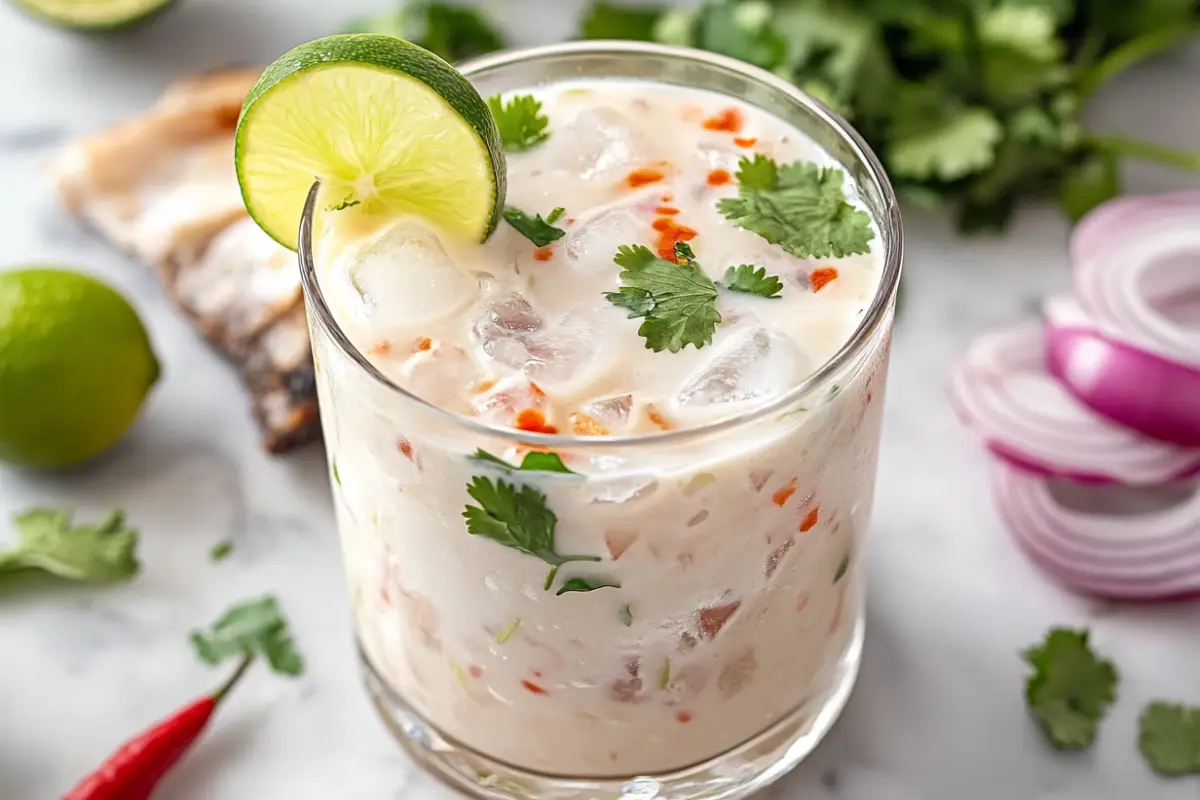Last Updated on March 7, 2025 by Simon
Peruvian cuisine is a vibrant celebration of fresh ingredients and bold flavors, with ceviche standing as one of its most iconic dishes. But if you’ve ever had ceviche, you’ve likely come across leche de tigre on the menu and wondered: what is the difference between ceviche and leche de tigre? The short answer? While both are rooted in the same citrus-based marinade, they serve different purposes and bring unique experiences to the table.
Ceviche is a dish of marinated raw fish or seafood, typically served with corn, sweet potato, and fresh herbs. In contrast, leche de tigre is the zesty, flavorful marinade itself, a tangy, spicy liquid that packs a punch. It’s often enjoyed as a shot, a sauce, or even a hangover cure!
Understanding the differences between these two is essential for anyone who loves Peruvian cuisine. Whether you’re a foodie, a home cook, or someone planning a culinary adventure to Peru, this guide will help you navigate the nuances of ceviche and leche de tigre with confidence. You’ll learn about their origins, ingredients, serving styles, and how both dishes fit into the broader context of Latin American food culture.
So, what makes them distinct? Let’s explore the details to reveal what makes ceviche and leche de tigre unique, how to make them, and why seafood lovers must try both.
Table of contents
- Why This Question Matters
- The Origins of Ceviche and Leche de Tigre
- What Is Ceviche?
- What Is Leche de Tigre?
- How Are Ceviche and Leche de Tigre Different?
- Unique Uses of Leche de Tigre
- Are There Variations of Ceviche and Leche de Tigre?
- Health Benefits of Ceviche and Leche de Tigre
- Modern Takes on Ceviche and Leche de Tigre
- Final Toughts
Why This Question Matters
The difference between ceviche and leche de tigre goes beyond just semantics, understanding it helps to appreciate the depth of Peruvian cuisine. Both are deeply rooted in Peru’s culinary heritage, but they serve different roles on the plate and bring distinct experiences to your taste buds.
Ceviche is a dish in itself, while leche de tigre is more of a sauce or marinade, though it’s often consumed on its own. But the nuances don’t stop there! Let’s explore the fundamental differences that make each unique, from their origins to their modern-day uses.
The Origins of Ceviche and Leche de Tigre
Ceviche is believed to date back thousands of years, with origins tracing to indigenous Peruvian coastal communities. These early versions of ceviche used local fish and acidic fruits to preserve seafood. When Spanish colonizers introduced limes in the 16th century, ceviche evolved into the dish we know today, featuring fresh fish cured in citrus juice.
Leche de tigre, on the other hand, came into prominence as a byproduct of ceviche. The marinade left at the bottom of a ceviche bowl, rich with lime juice, fish juices, and spices became a beloved concoction in its own right. Over time, chefs began perfecting this tangy liquid to serve as an accompaniment, a dipping sauce, or even a drink.
Today, both ceviche and leche de tigre are staples of Peruvian cuisine, with variations found across Latin America and beyond.
What Is Ceviche?

Ceviche is a seafood dish made by marinating raw fish or shellfish in citrus juice (usually lime or lemon), which “cooks” the protein through a process called denaturation. The acid breaks down the proteins in the fish, changing its texture and color, similar to heat-based cooking.
Key Components of Ceviche
- Fresh fish or seafood: Typically white fish like sea bass or snapper, but shrimp, octopus, and scallops are also common.
- Citrus juice: The essential component that cures the fish. Lime is the most traditional choice.
- Aromatic ingredients: Red onions, cilantro, and chili peppers (like aji amarillo or rocoto) give ceviche its bold flavor.
- Side dishes: In Peru, ceviche is often served with boiled corn, sweet potato, or plantain chips for balance.
People typically enjoy ceviche as an appetizer or main course, savoring it fresh. Peruvians consider it a symbol of their identity and even celebrate it with a national holiday every June 28th!
What Is Leche de Tigre?
Leche de tigre (which translates to “tiger’s milk”) marinates ceviche with its citrus-based blend. However, it’s more than a leftover liquid, it bursts with flavor from lime juice, fish juices, spices, and aromatics.
Leche de tigre has grown in popularity as a stand-alone element in Peruvian cuisine. It’s often served in small glasses as a shot, used as a dressing or dipping sauce, or even added to cocktails for a unique twist.
Key Components of Leche de Tigre
- Lime juice: The base of the marinade, providing acidity and freshness.
- Fish juices: Extracted from the seafood used in ceviche, giving it a rich umami flavor.
- Aromatics and spices: Garlic, cilantro, red onions, and chili peppers are key additions.
- Salt and pepper: Essential seasonings to enhance the overall flavor.
Some versions of leche de tigre also include fish stock or celery juice, creating a more complex liquid. It’s often served spicy, thanks to the addition of Peruvian chili peppers.
How Are Ceviche and Leche de Tigre Different?
Let’s break down the key differences between ceviche and leche de tigre:
| Aspect | Ceviche | Leche de Tigre |
|---|---|---|
| What It Is | A dish of marinated seafood | The citrus-based marinade used in ceviche |
| Main Ingredient | Fresh fish or seafood | Lime juice and fish juices |
| How It’s Consumed | Eaten as a meal or appetizer | Drunk as a shot or used as a sauce |
| Texture | Chunky, with pieces of fish | Liquid, often smooth and spicy |
| Common Uses | Main dish, appetizer | Sauce, marinade, hangover cure |
Ceviche takes center stage on the plate, but many consider leche de tigre a bold, tangy sidekick that shines on its own as a palate-awakening shot or dipping sauce.
Unique Uses of Leche de Tigre
Leche de tigre isn’t just for ceviche, it has several unique culinary uses that make it versatile in the kitchen:
- Hangover Cure: In Peru, leche de tigre is famed for its ability to cure a hangover. The combination of lime juice, salt, and chili is said to reinvigorate the body after a long night.
- Marinade for Other Dishes: It can be used to marinate meats like chicken or shrimp, adding a bright, citrusy kick.
- Cocktail Ingredient: Some mixologists have begun incorporating leche de tigre into cocktails for a unique, savory twist.
- Dipping Sauce: It works well as a dipping sauce for fried seafood or plantain chips.
Are There Variations of Ceviche and Leche de Tigre?
Yes! Both ceviche and leche de tigre have regional variations across Latin America:
- Ecuadorian Ceviche: Uses cooked shrimp and orange juice instead of lime.
- Mexican Ceviche: Often features tomatoes, avocado, and additional spices.
- Spicy Leche de Tigre: In some regions, extra chilies are added to make it spicier.
- Creamy Leche de Tigre: Some chefs add evaporated milk for a richer, creamier version.
Health Benefits of Ceviche and Leche de Tigre

Ceviche and leche de tigre aren’t just delicious they’re also packed with health benefits that make them great additions to a balanced diet. With fresh ingredients like fish, citrus, herbs, and chili peppers, both dishes offer a wealth of nutritional value and are naturally low in calories and high in essential nutrients. Here’s a breakdown of the key health benefits of these iconic Peruvian staples.
1. High in Lean Protein
Ceviche is typically made with fresh fish or shellfish, which are excellent sources of lean protein. Protein is essential for muscle repair, immune function, and overall body maintenance. Fish like sea bass, snapper, and shrimp, commonly used in ceviche, provide high-quality protein without the saturated fats found in red meats.
Leche de tigre, made from the juices of marinated seafood, retains protein from the fish used in ceviche. It may not be as protein-rich as the dish itself, but it still provides a nutrient boost.
2. Rich in Omega-3 Fatty Acids
The seafood in ceviche is a great source of omega-3 fatty acids, which are essential for heart health. Omega-3s help to:
- Lower blood pressure
- Reduce inflammation
- Support brain health and cognitive function
Adding more omega-3s to your diet can also help reduce the risk of heart disease, stroke, and arthritis. This makes ceviche an excellent choice for anyone looking to improve their cardiovascular health.
3. Packed with Vitamins and Minerals
Both ceviche and leche de tigre are made with fresh lime juice, which is high in vitamin C. Vitamin C is a powerful antioxidant that:
- Boosts the immune system
- Supports collagen production for healthy skin
- Promotes faster wound healing
Ceviche often includes red onions, cilantro, and chili peppers, all of which are rich in vitamins and minerals. Red onions provide antioxidants and anti-inflammatory compounds, while chili peppers deliver vitamin A and capsaicin, which may boost metabolism and reduce pain.
4. Low in Calories and Carbohydrates
One of the biggest advantages of ceviche is that it’s a low-calorie, low-carb dish. Unlike fried or breaded seafood options, ceviche is made with simple, fresh ingredients, making it an excellent choice for those on a low-calorie or low-carb diet.
Leche de tigre, being mostly liquid, is also low in calories but still provides bold, satisfying flavor. It’s a great way to enjoy a nutrient-dense snack or drink without overloading on calories.
5. Naturally Gluten-Free and Dairy-Free
For people with dietary restrictions, ceviche and leche de tigre are naturally gluten-free and dairy-free, making them suitable for individuals with celiac disease or lactose intolerance.
Modern Takes on Ceviche and Leche de Tigre
While ceviche and leche de tigre remain deeply rooted in Peruvian culinary traditions, chefs around the world have started to experiment with modern interpretations of these classics. From fusion dishes to innovative cocktails, both ceviche and leche de tigre are evolving to fit the global culinary landscape. Let’s explore some exciting modern takes on these iconic flavors.

1. Asian-Peruvian Fusion Ceviche
In recent years, the popularity of Nikkei cuisine (a fusion of Japanese and Peruvian flavors) has grown tremendously. Nikkei ceviche incorporates ingredients like soy sauce, sesame oil, and wasabi, giving the dish a bold umami twist.
One popular variation is tuna ceviche with avocado, ponzu sauce, and sesame seeds, combining the freshness of ceviche with the complex flavors of Japanese cuisine.
2. Tropical Fruit Ceviche
Another modern twist on traditional ceviche is the addition of tropical fruits like mango, pineapple, or passion fruit. These fruits add a sweet contrast to the tangy lime juice and spicy chili peppers, creating a dish that’s both refreshing and unexpected.
Tropical ceviche often serves as a summer appetizer or a beachside dish, with its fruity flavors enhancing the light, citrusy marinade.
3. Leche de Tigre Cocktails
Perhaps one of the most innovative uses of leche de tigre is in cocktail making. Some bartenders have started using leche de tigre as a base for savory cocktails, similar to how Bloody Marys are made.
One popular example is the Pisco Sour with Leche de Tigre, a creative spin on Peru’s national cocktail. The tangy, spicy leche de tigre adds a zesty kick to the traditional pisco sour, making it a hit at trendy bars and restaurants.
4. Vegan Ceviche and Leche de Tigre
With the rise of plant-based eating, chefs have also developed vegan versions of ceviche and leche de tigre. Instead of fish, they use mushrooms, hearts of palm, or jackfruit to replicate the texture of seafood.
For leche de tigre, chefs replace the fish stock with vegetable broth, lime juice, and spices, creating a vegan-friendly marinade that retains all the bold flavors of the original.
5. Deconstructed Ceviche
Some modern restaurants serve deconstructed ceviche, where the fish, lime juice, and garnishes are served separately on the plate. This allows diners to customize the flavor of their dish and gives a more upscale, artistic presentation.
In these versions, the leche de tigre is often served in a separate shot glass, allowing guests to enjoy it on its own or pour it over the dish.
6. Leche de Tigre as a Sauce for Other Dishes
Modern chefs have also started using leche de tigre as a sauce for non-seafood dishes. They drizzle it over grilled meats, roasted vegetables, or even pasta for a unique Peruvian twist.
One popular dish is grilled octopus with leche de tigre sauce, where the tangy marinade enhances the smoky flavors of the charred seafood.
Final Toughts
In the world of Peruvian cuisine, ceviche and leche de tigre are inseparable yet distinct elements that offer complementary experiences. Ceviche features marinated seafood, loved for its bright, fresh flavors, while leche de tigre enhances it with a zesty, tangy kick, and also shines on its own as a flavor-packed sauce or drink.
Understanding the differences between these two iconic components allows you to appreciate the nuances of Peruvian cuisine and explore new ways to enjoy them, whether you’re trying a classic ceviche, sipping on a shot of leche de tigre, or experimenting with modern fusion dishes.
For those eager to discover authentic Peruvian flavors, both ceviche and leche de tigre offer a sensory adventure that’s as vibrant and dynamic as the country itself. Whether you’re dining at a traditional Peruvian restaurant or preparing these dishes at home, you now have the knowledge to enjoy them with a deeper understanding and appreciation.
Ready to explore more? Check out our guides to other Peruvian classics and learn how to bring Latin American flavors into your kitchen!
If you’re intrigued by the bold, zesty flavors of leche de tigre, don’t miss our detailed guide, How to Make Leche de Tigre Recipe: The Ultimate Peruvian Elixir. Discover step-by-step instructions, tips, and creative ways to enjoy this vibrant Peruvian classic!

